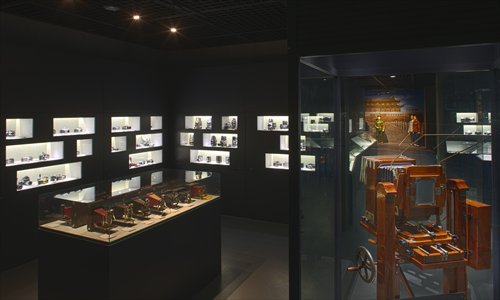A snapshot of history
Chen Haiwen has many different titles after his name, among them the chairman of Shanghai Sanya Culture Communication and Exhibition Company, the vice chairman of the Shanghai Photographers' Association, and one of the city's Chinese People's Political Consultative Conference (CPPCC) members. And now his business card will have to make room for one more title: that of the founder of the Shanghai Museum of Old Camera Manufacturing (SMOCM).
The SMOCM was opened in Huangpu district on June 9, and it is now three years since Chen first announced plans to find a venue in the city to exhibit old Chinese-made cameras, and also to showcase the manufacturing processes behind them.

Homemade products
The museum is displaying more than 100 Chinese-made cameras, and more than 80 overseas models. Some 200 camera components are also being exhibited. Visitors can see every brand and model of mechanical camera that was made in Shanghai during the 1950s when local manufacturers first tried their hand at homemade products. There are also examples of cameras created by the other 34 manufacturers around the country from the 1950s to the 1970s.
The Dongfeng 120, produced by the former Shanghai Camera Factory (now Shanghai Seagull Camera Company) in 1969, and the Hongqi 20, produced by the former Shanghai No.2 Camera Factory, also in 1969, are two highlights on show. They were both modeled after the technologically advanced, foreign-made cameras of that time, but the production output of these two models was minimal; just 97 for the Dongfeng 120 and 271 for the Hongqi 20.
Visitors can also see four camera models from the Shanghai 58 Series at the museum. "I doubt whether you will ever see these four cameras appearing together in the same place again," said Zhu Zongxun, who started to collect old cameras in the 1980s. "For example only 11 were made of one of the models, the Shanghai 58-IV."
Zhu has contributed part of his private collection to the museum, including an example of the first Chinese-made single-lens reflex camera, the Zijinshan Z-135.
Among the overseas brand vintage cameras visitors can see are German-made Leica and Rollei cameras, American-made Kodaks, and Swedish-made Hasselblad cameras.
Recalling glory days
In 2009, Chen purchased the production line for the twin-lens reflex mechanical camera the Seagull 4A-109, from the Shanghai Seagull Camera Company. The original production had stopped in 2004 and with the remaining unused components from that time, Chen has restarted the production line.
And now this operation has been moved into the premises of SMOCM where visitors can see dozens of former Shanghai Camera Factory workers (previously retired but now re-employed) busy assembling the cameras. Each of the cameras contains 407 components, requiring 89 procedures in order to complete a finished product. On average, it takes the workforce one day to finish a camera.
"I remember that the production output during my time in the former factory could reach 10,000 or more per month," said 64-year-old worker Han Yulong, who recalled that more than 6,000 workers were employed in the factory in the early 1980s.
It is estimated that Chen's new production line will be able to make about 1,000 more cameras using up the remaining components that he purchased in 2009. To date, 500 "new" cameras have already been manufactured. Unfortunately no new source of these components has been found, and Chen is concerned as to how to carry on production when the current supply is exhausted.
"Now I am almost reluctant to let the workers make the cameras, because the more they produce, the sooner the end of the production line will arrive!" lamented Chen. "As long as we can keep making them, it means that the story of this Chinese camera has not ended."
Chen has been trying to contact the other 34 factories scattered across China in search of the elusive parts and molds needed to keep the production of the Seagull 4A-109 alive. Today the camera retails for 5,800 yuan ($911), and is available at Chen's store in Tianzifang (Lane 210 Taikang Road) and also on taobao.com.
Cultural life
It was in the 1950s that the indigenous Chinese camera industry first appeared, with dozens of factories springing up all over the country between 1956 and 1960. In the following 30 years, these cameras constituted an important part of cultural life.
However, the fierce competition brought about by China's opening-up in the 1980s proved too much for many manufacturers, with only two companies, Seagull in Shanghai and Phoenix in Jiangxi Province, surviving into the 21st century. Today, Japanese-made cameras account for a large share of the Chinese photographic market.
"Seeing these old Chinese cameras makes me feel like a pop fan when they see one of their idols," 26-year-old Canon camera user Tang Ge told the Global Times while he was visiting the museum. "The Chinese camera industry has lagged far behind their Japanese counterparts, but I hope this can be a spur to their improvement."
Chen also admitted that he became a professional photographer using imported cameras. But he expressed the wish that his museum will remind Chinese people to pay more attention to the rejuvenation of the country's homegrown camera industry.
Add: 308 Chongqing Road South
重庆南路308号
Tel: 6093-2278
Opening hours: 10 am to 4 pm (closed on Mondays)